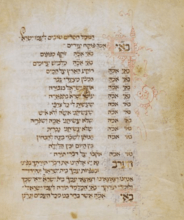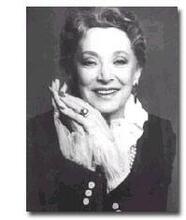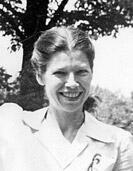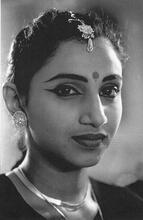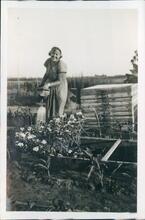Mollie Parnis
Mollie Parnis was equally famed for her New York salons that welcomed literary and political giants and for her fashion designs that adorned first ladies. Parnis’ dresses regularly appeared in Vogue, Harper’s Bazaar, and Vanity Fair, and she designed outfits for Mamie Eisenhower, Bess Truman, Lady Bird Johnson, and Patricia Nixon. Despite her lack of formal education, she held weekly salons where she could talk with journalists, politicians, and celebrities. A longtime philanthropist, she created the Mollie Parnis Livingston Foundation in 1984, as well as the Livingston Awards for journalism. She served on the board of the Parsons School of Design and was a founding member of the Council of Fashion Designers of America.
Mollie Parnis’s wit and fashion-savvy made her clothing designs a must among many first ladies during her tenure as a fashion legend. Throughout her reign on Seventh Avenue in New York’s fashion district, Parnis often gave voice to a very spirited manifesto that strongly expressed how she governed her fashion house. She explained her idea of fashion with a mix of practical theory and a disciplined manner of observation. “Fashion is individual, not a series of rules,” she maintained staunchly when defining the standards necessary in beautifying the female body. Fashion was meant to enhance the intrinsic beauty of a woman, not overpower her. Adhering to this philosophy allowed her to uphold her reputation as a directed and driven perfectionist, not interested in starting fads, but instead in complimenting and assisting the very essence of a woman. “My clothes have a little sex. Too much is obvious. And anyway, I have put the sexiest dresses on some dames and nothing helps,” she once stated.
Early life and education
Parnis never discussed her age in public or validated any dates ever proposed by journalists. However, the most accurate and probable date of her birth was March 18, 1905. Born in Brooklyn, but raised mostly in Manhattan’s Lower East Side, Mollie, her three sisters, and brother experienced a lower-middle-class upbringing, with very few extras to help ignite the eventual fashion careers of three of the siblings. In later years, her sister Jerry, with husband Ben Cahane, headed the design firm of Jerry Parnis, Incorporated, an apparel manufacturing company that mass-produced moderately priced dresses. Peggy Parnis married Sol Hochman, owner of Chevette, Incorporated, and became head designer of his lingerie company.
Both parents, Abraham and Sara (Rosen) Parnis, were Jews who had emigrated from Linberg, Austria, at the turn of the century. Her father sold butter and eggs wholesale until he died when Mollie was ten. At that point, the family’s finances were the responsibility of her mother, who went to work immediately. The older children worked as well. At age eight, Mollie Parnis began her first career as an English tutor to foreigners for twenty-five cents per hour. With the support of her family she attended Wadleigh High, on the Upper West Side, and soon after graduation her first and only pursuit at formal education came with her enrollment at Hunter College. Her intention was to study law, but her attempt was overshadowed by her ultimate vocation.
Introduction to fashion
Her interest in fashion may have been precipitated in part by an incident in high school. Since amenities were few, ingenuity and necessity prevailed when a high school classmate asked her to a party after a football rally. Having no other dress than the navy blue serge she had been wearing at the rally, she quickly raced home to rearrange and redesign the only day dress she owned. While snipping the neckline, adding lace, and sewing on the finishing touch of an artificial flower, her first creation was realized. This momentary scene in Parnis’s young adult life may have been the subconscious stimulus for her entry into an industry that she would, in due time, enrich and influence on many levels.
With the help and encouragement of a family connection, at age eighteen Parnis was hired to work as an assistant saleswoman for a wholesale blouse manufacturer. At the blouse company, she impressed the owners with her eye for detail and her ability to satisfy the needs of retail buyers by adding finishing touches on blouses to create distinction and a variety of style. Instead of giving Parnis a raise, the owners added her name to the building directory, arousing her first taste of fame. “Well, you don’t know what that did for me,” she said. “I got so excited over it, I had all my friends come over to Seventh Avenue to look at ‘Mollie Parnis, 4th Floor.’ It was like an actress having her name up in lights for the first time.”
Parnis Livingston, Inc.
Her next position, in 1929, was as a stylist for the dress house of David Westheim. This was a particularly auspicious move, as she met there Leon Livingston (originally Levinson), a textile salesman, and married him on June 26, 1930. For three years, Parnis was a wife and a mother to her only child, Robert. By 1933, during the height of the Depression, when most manufacturers were going out of business, Parnis and her husband opened the doors of Parnis Livingston, Incorporated.
In the beginning, Livingston was the business talent, while Parnis dominated the creative direction of the company. Their success was due in part to Parnis’s ability to oversee a staff of designers who could interpret and carry to fruition her vision of fashion. Although unable to cut, sew, or draw herself, having never had any type of design education, Parnis engineered her business with an astute eye for detail and knowledge of what the American woman wanted in her wardrobe. In no time, the husband and wife business partnership secured for Parnis Livingston the position of a major silk-dress house on Seventh Avenue.
From this point on, Mollie Parnis’s designs were characterized by quality, fit, and the essential use of refined fabrics. Her unique styling sense gave women over the age of thirty the opportunity to dress with elegance and beauty without compromising the integrity of the form and function of the dress or the individual body. Throughout the 1940s and 1950s, and even until the early 1980s, Parnis’s creations graced the style and advertising pages of Vogue, Harper’s Bazaar, Vanity Fair, and Life, among other magazines. Her designs were photographed by fashion giants such as Horst P. Horst, Toni Frissell, and Louise Dahl-Wolfe. By 1966, a Parnis dress had made the cover of Harper’s Bazaar with the caption, “50 great American dresses for the year of the dress.” Parnis had arrived.
After Parnis Livingston
The death of her husband in 1962 ended the Parnis Livingston business partnership. However, within three months the company reopened its doors and evolved. The strategy for the second phase of the dress house was engineered, in part, to fulfill the economic and lifestyle needs of the metamorphic American woman. Secondary lines, such as the “Mollie Parnis Boutique Collection,” debuted in 1970, under the direction of Mollie Parnis and with the design talent of Morty Sussman. At this time, two new labels were developed in response to a rising informal popular culture that had expanded the roles and demands of women in the home and in the workplace. The “Mollie Robert” label was formed to provide working women with affordable styling, while “Mollie Parnis Studio” directed its efforts toward the younger, independent consumer just entering the workforce.
The prestige house of Mollie Parnis remained strong with the design influence of George Samen, until 1984, when Parnis closed her doors on Seventh Avenue for the last time. Unable to completely leave the business she had grown up in, she developed “Mollie Parnis at Home,” a lounge-wear collection for Chevette Lingerie in the fall of 1985. Regardless of the price points of her creations, an overview of Parnis’s work shows a strict adherence to a very contemporary and constantly reinventive outlook. She never strayed from her policy of excellence in her vision of elegant clothing. She knew better than most that fashion is a temporal medium that expresses itself most succinctly within a particular period and, although she did not believe in creating curiosities, she always seized the opportunity to present the height of fine fashion to the American woman.
Beyond fashion: social life and philanthropic work
Aside from her devotion to her profession, Parnis’s famous Sunday evening salons were the highlight and the result of her commitment to sustain a broad life-style. Complete with art and music, and featuring an intimate circle of prominent politicians, journalists (of particular interest to her), writers, artists, and New York socialites, an evening with Parnis was designed to capture the spirit of a true epicurean. Her gracious manner allowed her guests the freedom and ease to speak candidly on all topics. Parnis was noted for her art collecting; her salon evenings would end with a viewing of a Matisse (her most prized possession), or an Utrillo or Cézanne, bought with great admiration for the beauty they bestowed on her private surroundings, both on Park Avenue and her weekend home in Katonah, New York.
Her generosity was often reciprocated, with dinner invitations extended from a roster of famous homes. Frequently chosen to visit the White House, Parnis often said that she wished her friends could see her now, shaking hands with the president and dressing the first lady. On one occasion in 1955, Mamie Eisenhower reportedly wore a green and blue silk taffeta Parnis dress to a Washington dinner, only to be met in the receiving line by a duplicate worn by a guest. In response to the fanfare at the time, Parnis declared that her designs were not singular in nature but were analogous to the great democracy of the United States. This incident did not dissuade Mrs. Eisenhower from purchasing future Parnis dresses, nor Bess Truman, Lady Bird Johnson, or Patricia Nixon.
Parnis also was a noted humanitarian. In 1971, she donated prize money to city programs such as “Dress up Your Neighborhood” and helped to create and promote vest-pocket parks throughout the New York boroughs. The success of these efforts led to her funding of a sister program in Jerusalem in 1973, to help beautify one of the oldest cities in the world.
In 1984, Parnis established the Mollie Parnis Livingston Foundation, which gave over $1.5 million to various charities. She contributed scholarships to fashion schools throughout the city and became a board member of the Parsons School of Design, which presented her with an honorary doctorate in 1989. In addition, Parnis was a founding member of the Council of Fashion Designers of America, and she also served on the board.
Perhaps her most availing philanthropic effort was the formation of the Livingston Awards, in honor of her son, Robert Livingston, publisher of More Magazine. His death in 1979 precipitated the development of three annual grants and citations for excellence for journalists under the age of thirty-five in all branches of media. Although Parnis never accomplished her dream of completing college, she made it possible for others to achieve their goals and hopes for the future.
Mollie Parnis died on July 18, 1992.
Bender, Marilyn. The Beautiful People (1967).
“Blue-Green on the National Scene.” Life (April 25, 1955).
Current Biography (1956).
“Dead, Mollie Parnis.” NYTimes, August 3, 1992.
Friedman, Arthur. “Memories of Mollie Parnis.” Women’s Wear Daily, September 16, 1992.
Lambert, Eleanor. World of Fashion (1965).
Lurie, Diana. “Close-Up: When Mollie Parnis Thinks a Dress Will Sell, It Goes.” Life (June 17, 1966).
McDowell’s Dictionary of Twentieth Century Fashion (1985).
Martin, Richard, ed. Contemporary Fashion (1995).
Morris, Bernadine, and Barbara Walz. The Fashion Makers (1978).
Murrow, Edward R. “Mollie Parnis at Home.” Person to Person. CBS, September 1955. Video.
Naylor, Colin, ed. Contemporary Designers. 2nd ed. (1991).
Parnis, Mollie. Costume collections. Costume Institute, Metropolitan Museum of Art, NYC, and Fashion Institute of Technology Museum, NYC. Designer files. Costume Institute Library.
Stagemeyer, Anne. Who’s Who in Fashion (1996).
“A Woman of Many Modes: Mollie Parnis Dead at 93.” Women’s Wear Daily, July 20, 1992.

